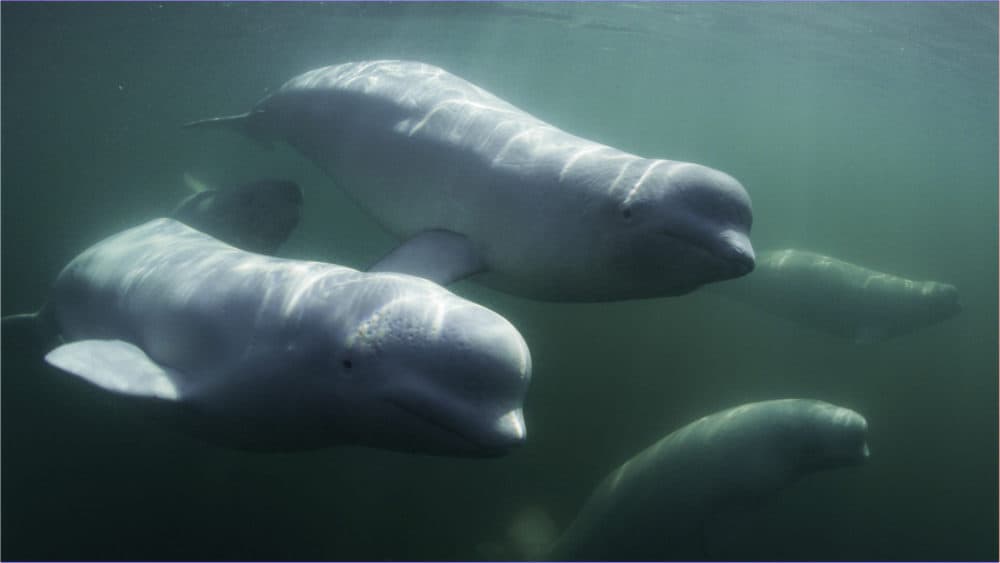Advertisement
Underwater Photographer Unveils 'Secrets Of The Whales'
Resume
Different whales around the world have their own distinctive cultures.
Their survival lifestyles are documented in “Secrets of the Whales,” a new National Geographic docuseries by filmmaker and underwater explorer James Cameron.
The documentary plunges into the complex ways that five different types of whales — orcas, narwhals, humpbacks, belugas and sperm whales — communicate and socialize.

World-renowned underwater photographer Brian Skerry spent three years diving in dozens of locations to capture these majestic creatures for the film. Skerry is no stranger to the dangerous depths of the ocean — he’s gotten up close and personal with some of the world’s most perilous sharks.
But documenting whales was an entirely different experience for Skerry because of the culture these marine mammals construct.
For example, orcas in New Zealand enjoy stingrays for food. They’ve mastered a technique where they grab the ray, flip the fish upside down and then immobilize it by putting it to sleep. They are the only known orca in the world that use this specific maneuver, he says.
But orcas in Patagonia prefer to devour sea lion pups and have developed their own technique — a method they teach to their calves — for capturing the four-flippered animals on the beach at a certain time every year, he says.
One of Skerry’s friends, scientist Shane Gero, has been studying sperm whale families in the Caribbean who have created their own dialect. If a sperm whale from another area swims into the waters of the Dominica sperm whales, the two parties communicate through dialect and go their own way if the dialects don’t match up. It’s like the whales designated their own neighborhoods based on language, Skerry says.
Advertisement
Researchers tend to refrain from using the word “language” to describe what the whales are doing because of the word’s human connotation. But in layman’s terms, “I think they are speaking a language,” he says.


In the series, Skerry experienced the chance of a lifetime when an adult female orca approached him with a stingray in her mouth. She approached and dropped the ray on the ocean floor before him. At that point, she swims out of Skerry’s view.
But then suddenly, “she swims behind me, comes around to the left side of my vision, and then the ray is between us on the ocean floor. And the whale is looking at me, looking at the ray, looking at me, looking at the ray, as if to say, ‘are you going to eat that?’ ” he recalls.
When he doesn’t eat the ray, “she very gently bends over, picks it up and turns,” he says. “And then another orca comes in, a member of her family, and they begin to food share.”
He talked to Cameron, the executive producer, about the situation afterward. Cameron reminded Skerry that food sharing is commonplace in many whale cultures, so this female whale was likely offering the photographer a meal.
Skerry says never felt fearful when getting close to the whales. He’d remain vigilant while taking pictures but says the whales were “extremely aware” of him, often darting around the photographer to avoid hitting him.
“You reach a rarefied plain when you're in the presence of highly cognitive, sentient animals like whales,” he says. “They are operating at a very different level.”
Unlike sharks and fish, he says whales possess big personalities and charm. So special moments underwater with the whales “transcends any other experience for me in the ocean,” he says.

“Secrets of the Whales” touches on the threat of ocean pollution and how it decimates marine animals and their habitats. There were scenarios during filming where crew members had to decide on a case-by-case basis whether to untangle sea animals from plastic fishing nets or debris. They witnessed one sea turtle in Sri Lanka tangled in a laundry basket, he remembers.
Each situation is independently evaluated because of the potential impact on fishermen’s livelihoods if a line is cut, he says.
Plastic in the ocean is in such abundance that if Skerry doesn’t spot trash during a dive, he considers it an anomaly, he says.
“The plastic problem is a huge one that I think is solvable,” he says. “But it's one of many.”
Ciku Theuri produced and edited this interview for broadcast with Tinku Ray. Serena McMahon adapted it for the web.
This segment aired on May 11, 2021.

